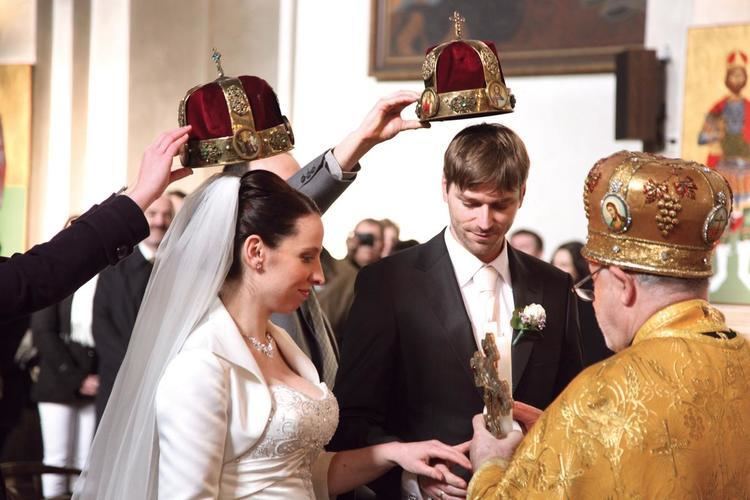 | ||
Ukrainian wedding is the traditional marriage ceremony in Ukrainian culture, both in Ukraine and in the Ukrainian diaspora. The traditional Ukrainian wedding featured a rich assortment of folk music and singing, dancing, and visual art, with rituals dating back to the pre-Christian era. Over time, the ancient pagan traditions and symbols were integrated into Christian ones.
Contents
Betrothal
Ivan Kupala Day – On the eve of the celebration of Ivan Kupala Day village folks would roam through the forests in search of paporot flower, an elusive and magical flower that brings great wealth. Unmarried women, wearing a Ukrainian wreath, would be the first to enter the forest. They are followed by young men. If the couple comes out with the young man wearing the girl's wreath, they are engaged to be married.
Paying the ransom – The groom must go to the bride's parent's house and offer a ransom to get his bride. The bridesmaids protect the bride from getting "stolen" without a ransom. First, the groom offers something valuable, usually money or jewellery for the bride. The parents of the bride bring out a woman or man dressed as the bride and covered with a veil, so the groom can't see her face. When the groom realizes that it is not his bride, he asks for his true love, and the family demands a bigger ransom because she is valuable. Once the ransom is negotiated, the bride's family offers the bride to the groom.
If the bride's parents meet the bridegroom at the door with a pumpkin, it means that his offer of marriage was not accepted by either the bride or by her family, and the pumpkin is something for him to carry, so that he doesn't leave empty-handed.
Blahoslovennia - This is a ritual blessing of the bride and groom by their parents. It usually takes place shortly before the wedding ceremony. The bride and bridegroom at their own homes with their parents and grandparents perform this ritual. When the bridegroom arrives as the bride's house, after he has paid ransom for his bride, the bride and bridegroom perform this ritual together, in front of both of their parents. In the combined blessing ceremony, the elder (starosta) first asks the couple's parents to sit on benches. Once seated, a long embroidered cloth, rushnyk is placed on their lap, and everyone is given a loaf of wedding bread. The starosta recites a ceremonial text such as the following: "As these two children stand before their own mother, before their own father, before their uncles, before their godparents; maybe they did not listen to one of you, I ask you to forgive them and bless them." In Ukrainian, the word proschannia is used to describe forgiving someone of their offenses as well as bidding them farewell. Then the family members repeat "Bih sviatyi" (May Holy God forgive and bless you) three times. The couple then bows to their parents and kisses their faces, hands, and feet. This blessing is performed three times. This ritual symbolizes forgiveness for any sins, and a blessing of the marriage from the parents.
Ceremony
The couple steps up on a rushnyk before they take their vows. Traditionally, the one who steps on the towel first, will have the final say throughout their marriage.
During the crowning ceremony, in a traditional wedding the bride's vinok is replaced by an ochipok and namitka, that covers her hair and shows that she is now married. The groom is also crowned with a hat, symbolic of him accepting responsibility as a man.
Vesellia
The wedding celebration can last days and sometimes weeks, with dancing, singing, long toasts, and a feast that includes the entire community.
Features
Traditional songs
Locations
Funerals
Young women who die unmarried are buried in a wedding dress in some areas.
